RIO-ANTIRRIO BRIDGE

Above is a photograph of the Rio-Antirrio Bridge taken from a ferry crossing the straits
PLEASE NOTE THAT ALL THE PHOTOGRAPHS ON THE SITE ARE CLICKABLE LINKS

Above is a photograph of the Rio-Antirrio Bridge taken from a ferry crossing the straits
PLEASE NOTE THAT ALL THE PHOTOGRAPHS ON THE SITE ARE CLICKABLE LINKS
This photograph was taken from inside the Rio Fortress.
More than a hundred years ago, an elder statesman dreamed of a new bridge in Europe. Of a way of cutting out an arduous 240km detour by road, or a 45-minute ferry ride often subject to bad weather. And of replacing it with what would eventually be an easy five-minute drive.
Though it would be many years before this dream became reality, the challenge was set. But the sheer scale of that challenge, of the obstacles and unforeseen difficulties it presented, would only be revealed in the fullness of time.
The vision of Charilaos Trikoupis, then Greek Prime Minister, would be to cross the Gulf of Corinth, connecting Rio on one side with Antirrio on the other. Opening up a whole new set of trade and travel opportunities from mainland Greece into the otherwise remote Peloponnese.
The Rio-Antirrio Bridge is the world's longest multi-span cable-stayed bridge. It crosses the Gulf of Corinth near Patras, linking the town of Rio on the Peloponnese to Antirrio on mainland Greece.
Work on the bridge began in July 1998 and the bridge was finally inaugurated on August 7, 2004, a week before the opening of the 2004 Summer Olympics in Athens.
The Olympic torchbearers were the first to officially cross its length. The total cost of the bridge was about 630,000,000 euros, mostly funded by the European Union. It was finished ahead of its original schedule and within budget.
The 2,880-metre-long bridge (approximately 1.8 miles) dramatically improves access to and from the Peloponnese, which could previously be reached only by ferry or via the isthmus of Corinth in the east. Its width is 28 m - it has two vehicle lanes per direction, an emergency lane and a pedestrian walkway.
Its five-span four-pylon cable-stayed portion of length 2,252 m is the world's second longest cable-stayed deck; only the deck of the Millau Viaduct in southern France is longer at 2,460 m. However, as the latter is also supported by bearings at the pylons apart from cable stays, the Rio-Antirrio Bridge deck might be considered the longest cable-stayed "suspended" deck.
This bridge is widely considered to be an engineering masterpiece owing to several solutions applied to span the difficult site. These difficulties include deep water, insecure materials for foundations, seismic activity, the probability of tsunamis, and the expansion of the Gulf of Corinth due to plate tectonics.
Due to the peculiar and difficult conditions of the straits, several unique engineering problems needed to be considered and overcome. The water depth reaches 65 m, the seabed is mostly of loose sediment, the seismic activity and possibility of tectonic movement is significant, and the Gulf of Corinth is expanding at a rate of about 30 mm a year.
In addition, the hills on either side create a wind tunnel where 70 mph winds are common.
In an early, major setback, the French-Greek consortium led by the French group Vinci SA discovered that the seabed beneath the crossing was made up of sand and silt for hundreds of meters down. With no solid bedrock, even at 450 meters, it looked impossible to build foundations, and Vincis initial design wouldn't work.
The bridge received the 2006 Outstanding Structure Award from the International Association for Bridge and Structural Engineering.
In 2011 the bridge was featured on TV in an episode of Richard Hammond's Engineering Connections. In 2015, construction of the bridge was chronicled in the first episode of the Science Channel series Impossible Engineering.
On 28 January 2005, six months after the opening of the bridge, one of the cable links of the bridge snapped from the top of the M1 pylon and came crashing down on the deck. Traffic was immediately halted.
The first investigation claimed that a fire had broken out on the top of the M1 pylon, after a lightning strike in one of the cables. The cable was immediately restored and the bridge reopened.
A structural health monitoring system was installed during construction on the bridge. Still operating, it provides a 24/7 surveillance of the structure. The system has more than 100 sensors, including:
One specific element of the system is the ability to detect and specifically treat earthquake events. It is said to be able to resist quakes reaching up to 7.4 on the Richter scale.
And this was put to the test back in 2008, when the area was hit by a tremor that caused buildings to collapse up to 25 kilometers away, killing two and injuring more. The bridge meanwhile was left unscathed, allowing emergency services to pass through as normal.